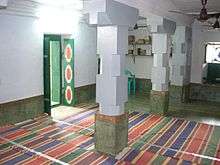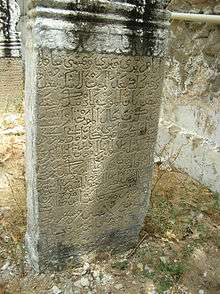Palaiya Jumma Palli
| Paḻaiya jum'mā paḷḷi பழைய ஜும்மா பள்ளி | |
|---|---|
 The Old Jumma Masjid Of Kilakarai | |
| Basic information | |
| Location | Kilakarai, Tamil Nadu, India |
| Geographic coordinates | 9°13′53″N 78°47′04″E / 9.2314°N 78.7844°ECoordinates: 9°13′53″N 78°47′04″E / 9.2314°N 78.7844°E |
| Affiliation | Islam |
| Region | Kilakarai |
| Architectural description | |
| Architect(s) | Bazan Ibn Sasan |
| Architectural type | Mosque |
| Architectural style | Dravidian Islamic architecture |
| Completed | 628-630 CE |
Palaiya Jumma Palli (Tamil: பழைய ஜும்மா பள்ளி, "The Old Jumma Masjid of Kilakarai" ) or Meen Kadai Palli (Tamil: மீன் கடை பள்ளி ) is a mosque in Kilakarai, Tamil Nadu, India. Built in 628-630 AD, it is believed to be one of the oldest mosques in the world and along with Cheraman Juma Masjid in Kodungallur, Kerala, the first mosque in India.[1][2] It has an Islamic heritage of more than 1000 years. It is located in Kilakarai, an ancient port town in the South Indian state of Tamil Nadu known for its Islamic culture. It was built in 628–630 AD and was re-constructed in 1036. The mosque along with the others in the town, is one of the greatest examples of Dravidian Islam architecture.[3]
History and Construction
Constructed by the Yemeni merchants and trade settlers of the pre-Islamic period in Pandiya kingdom ordered by Baadhan (Bazan ibn Sasan) Governor of Yemen at the time of Prophet Muhammad, after they accepted Islam in 625–628 AD at the time of Kavadh II son of Khosrau II (king of Persia). This mosque was rebuilt in the 11th century after saheed war. It is the oldest mosque of India. Bazan Ibn Sasan, Tamim Ibn zayd al ansari, Ibnu Batutah, Nagoor Abdul Cadir, Ervadi Ibrahim Sahib, Sultan of Ottoman Murad and other most famous Islamic scholars visited the mosque and Ibnu Batutah said in his travel notes "it's the place of where most arab settlers live and he surprised to see them living as in Arab land".
Structure
The mosque looks like a temple from outside and inside, but does not have any idol carving on the pillars or walls. There is the Mihrab on the wall like all mosques for identifying the direction of prayer, which is the only proof that it is a mosque. Elaborate carvings are present on the surfaces of the walls of the mosque and lofty beams are also present in the 'pallavasal' of the mosque. The mosque bears a Tamil architectural look, which implies a distinctive architectural pattern.
Gallery
 Tamil Islamic architectural features
Tamil Islamic architectural features


 Tombstone in Arwi script
Tombstone in Arwi script
See also
- Kilakarai
- Kilakarai Moors
- Arwi
- Bazan Ibn Sasan
- List of mosques in India
- List of the oldest mosques in the world
References
- ↑ Gibb & Beckingham 1994, pp. 814–815 Vol. 4.
- ↑ Krishna, Nanditha. "KILAKARAI-THE OLDEST MOSQUE IN INDIA". Heritageonlinefoundation. Retrieved 7 March 2015.
- ↑ "Documentary on Tamil Muslims inspires approach to Tamil national struggle". TamilNet. Retrieved 15 February 2015.